Introduction
A SWOT analysis is a powerful tool for organizations to assess their internal strengths and weaknesses, as well as external opportunities and threats. It provides a comprehensive view of the business landscape and helps inform strategic decision-making. This analytical process can be applied to both the overall business and specific projects within an organization.
By identifying strengths, weaknesses, opportunities, and threats, companies can craft strategies that leverage their advantages, address weaknesses, capitalize on market trends, and mitigate risks. In this article, we will explore the importance of conducting a SWOT analysis, how to perform one effectively, and practical examples of its application in various industries. By embracing the SWOT structure, businesses can navigate the complexities of the marketplace and develop actionable plans for long-term success.
What is a SWOT Analysis?
A SWOT analysis serves as a comprehensive instrument for identifying internal competencies and shortcomings, alongside external chances and risks. This analytical process is not a one-size-fits-all; it's versatile enough to be applied both to an entire business and to specific projects within an organization. It's particularly crucial for strategizing and understanding where the business stands and where it could potentially go.
Consider the case of a company pondering its objectives for the upcoming year. They can deploy a SWOT analysis to systematically catalogue internal strengths like a robust financial foundation or pioneering technology, and weaknesses which may encompass any internal limitation. Externally, opportunities might arise from market trends or shifts in consumer behavior, while threats could manifest as a new market competitor or economic downturns.
Industry examples demonstrate the breadth of the SWOT analysis application. Companies that have clinched awards for innovative business models or those venturing into new territories with ground-breaking green technology exemplify how SWOT can underpin strategic advancement. For instance, a company recognized for an innovative broadband rollout understands its strength lies in the wholesale model it has chosen.
Similarly, an enterprise launching the first sole alternative fuel transatlantic flight understands its opportunity in market differentiation.
In the context of staff satisfaction and customer experience, strengths could be reflected in an organization's highly skilled workforce or a strong reputation in the market—attributes that afford it an edge over competitors.
Bear in mind, this analysis is not just theoretical; its implications are tangible and can profoundly affect operational, technical, economic, and administrative dimensions of a project. By embracing the SWOT structure, businesses are equipped to craft strategies that leverage strong points, navigate weaknesses, harness opportunities, and mitigate threats.
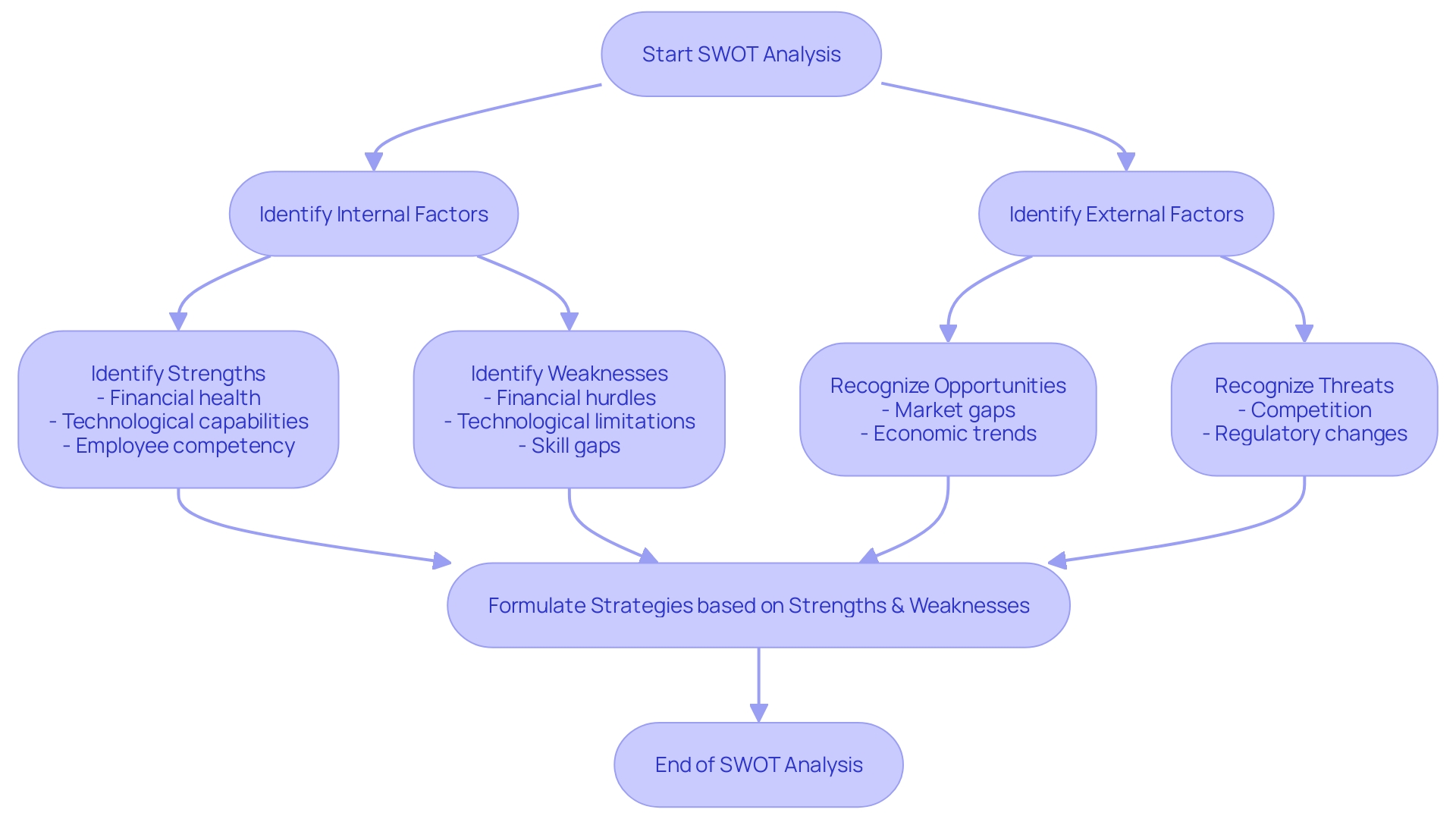
Why Conduct a SWOT Analysis?
Mastering a SWOT analysis is a pivotal step toward strategic insight for any business. This tool crystallizes an organization's internal strengths and weaknesses, alongside external opportunities and threats, hence offering a balanced overview of the competitive landscape. Confronted with the dynamic nature of markets, deploying a SWOT analysis enables companies to not only harness their inherent advantages but also fortify against inherent susceptibilities.
Simultaneously, it underscores potential external levers for growth and cautions against possible risks that may lurk in the operational environment.
To articulate, strengths encapsulate what an enterprise excels at, distinguishing its offerings from industry counterparts—be it through superior expertise, solid financial underpinnings, or innovation prowess. Knowing these attributes allows businesses to leverage them towards accomplishing their annual objectives. Conversely, weaknesses are those facets where the company lags, signifying areas ripe for improvement or strategic overhaul.
Adopting an external vantage point, opportunities are favorable circumstances in the broader market that the business might exploit for advancement. In contrast, threats signify external contingencies beyond corporate control, such as economic fluctuations or intensifying competition, which require preemptive strategic contingencies. Reflecting on both can guide businesses in reshaping their strategic trajectories.
The pragmatic utility of a SWOT analysis is exemplified in its informative brevity. With a concise yet comprehensive structure, it provides quick insights, fostering dialogue and insight development among stakeholders to prioritize strategy. This visualization not only simplifies comprehension of intricate market dynamics but is also instrumental in shaping actionable plans attuned with both the company’s capabilities and the realities of the marketplace.
Businesses that harness this methodology emerge better prepared, with a strategic mindset engineered for long-haul triumph.
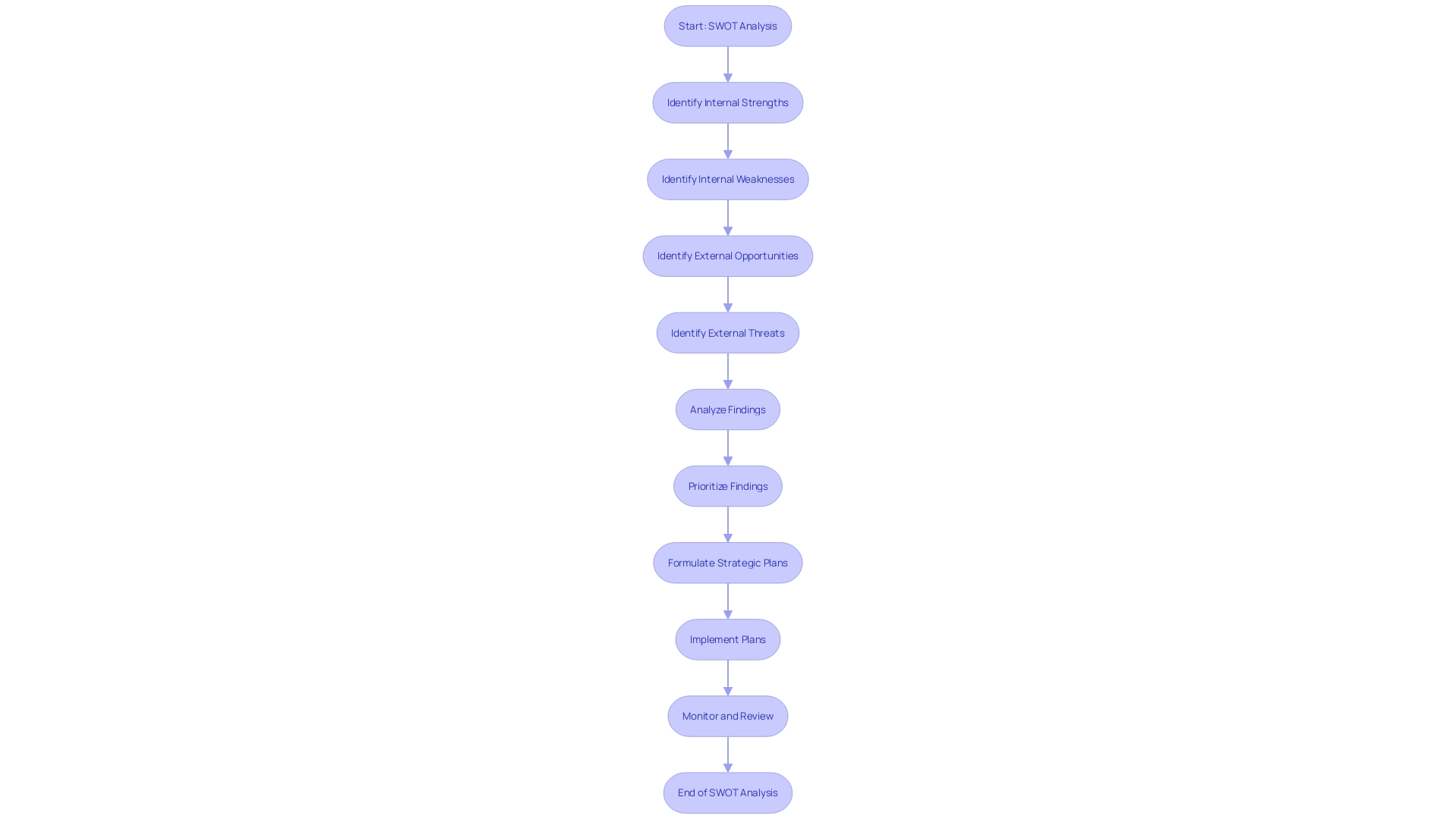
How to Perform a SWOT Analysis
A SWOT analysis furnishes organizations with a rigorous framework to scrutinize their competitive stance by pinpointing internal strengths and weaknesses alongside external opportunities and threats. This structured approach facilitates informed strategy crafting.
For instance, strengths are the organization's intrinsic advantages, like robust financial health or state-of-the-art technology, propelling it ahead of competitors. Identifying these helps businesses harness and build upon them.
Weaknesses, conversely, are internal factors that may deter an organization's progress—recognition of which is critical for mitigation and improvement.
Opportunities emerge from the market or industry trends—such as new technologies or shifts in consumer preferences—that the organization can exploit. Vigilant market research, including demographic analysis and demand assessment, underpins the discovery of such prospects.
Lastly, threats encompass elements beyond the organization's influence, like economic downturns, legislative changes, competitive dynamics, or workforce scarcities. Recognizing these potential challenges is vital for strategic risk management and contingency planning.
Sectors across the spectrum, from fledgling startups to established entities, adopt SWOT analyses to hone their strategic direction, each element of the analysis offering a perspective pivotal for overarching business planning.
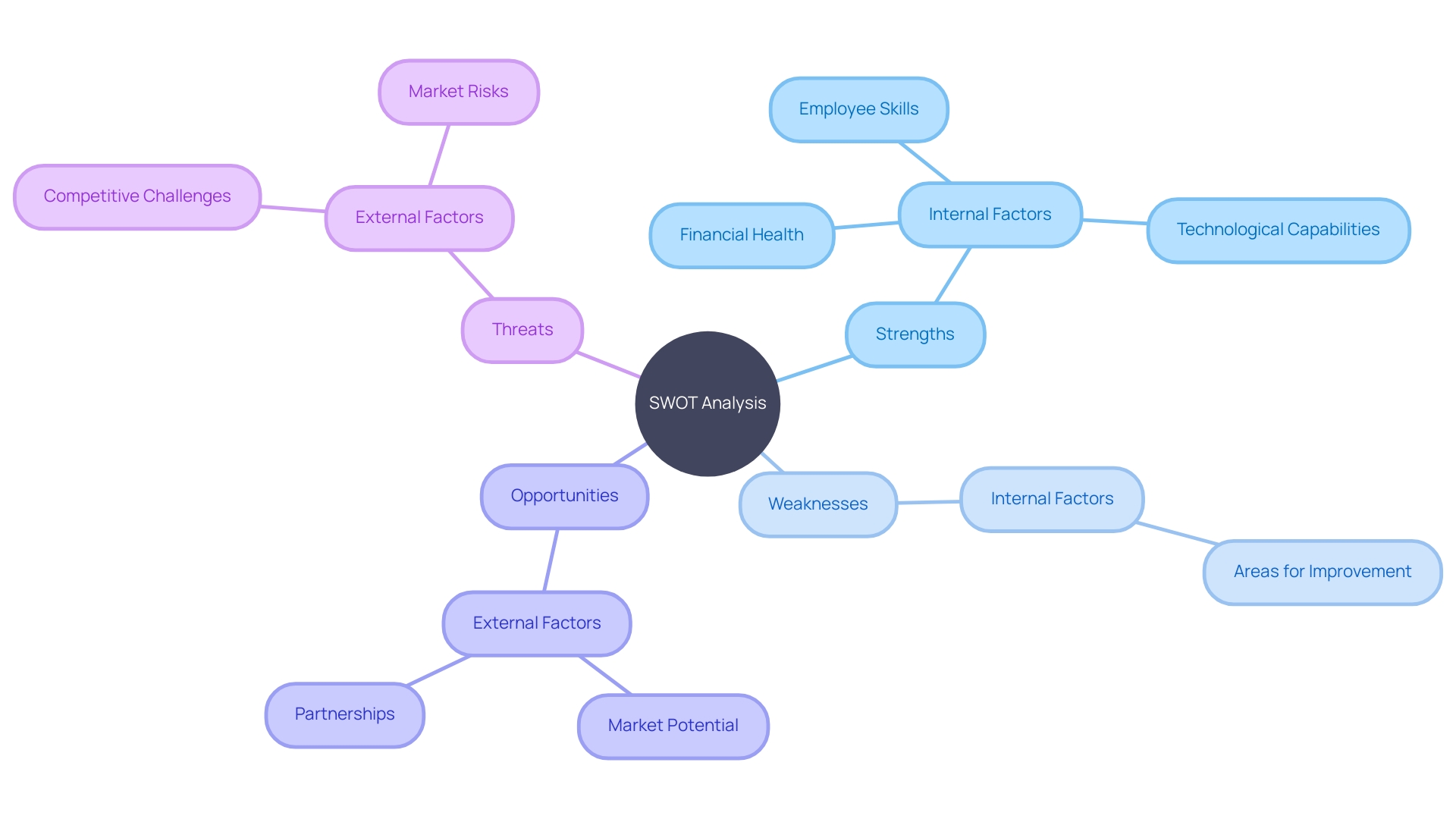
Identifying Strengths
Identifying a company's strengths goes beyond recognizing its tangible assets; it involves understanding the distinctive qualities that make it stand out in the market. For instance, Spotify's dominance in the music streaming industry can be attributed to its unique combination of a user-friendly platform, a vast library of content, and proprietary algorithms like Discover Weekly and Release Radar that provide personalized experiences for its over 500 million active users. Similarly, an effective SWOT analysis could identify how a hotel company's strategic implementation of digital marketing tools and analytics, alongside robust keyword research, allowed them to enhance their online visibility and bookings.
Emphasizing the internal factors that shape success, such as exclusive licensing deals or advanced user engagement strategies, clarifies a business's competitive advantages and underpins strategic decisions that propel growth.
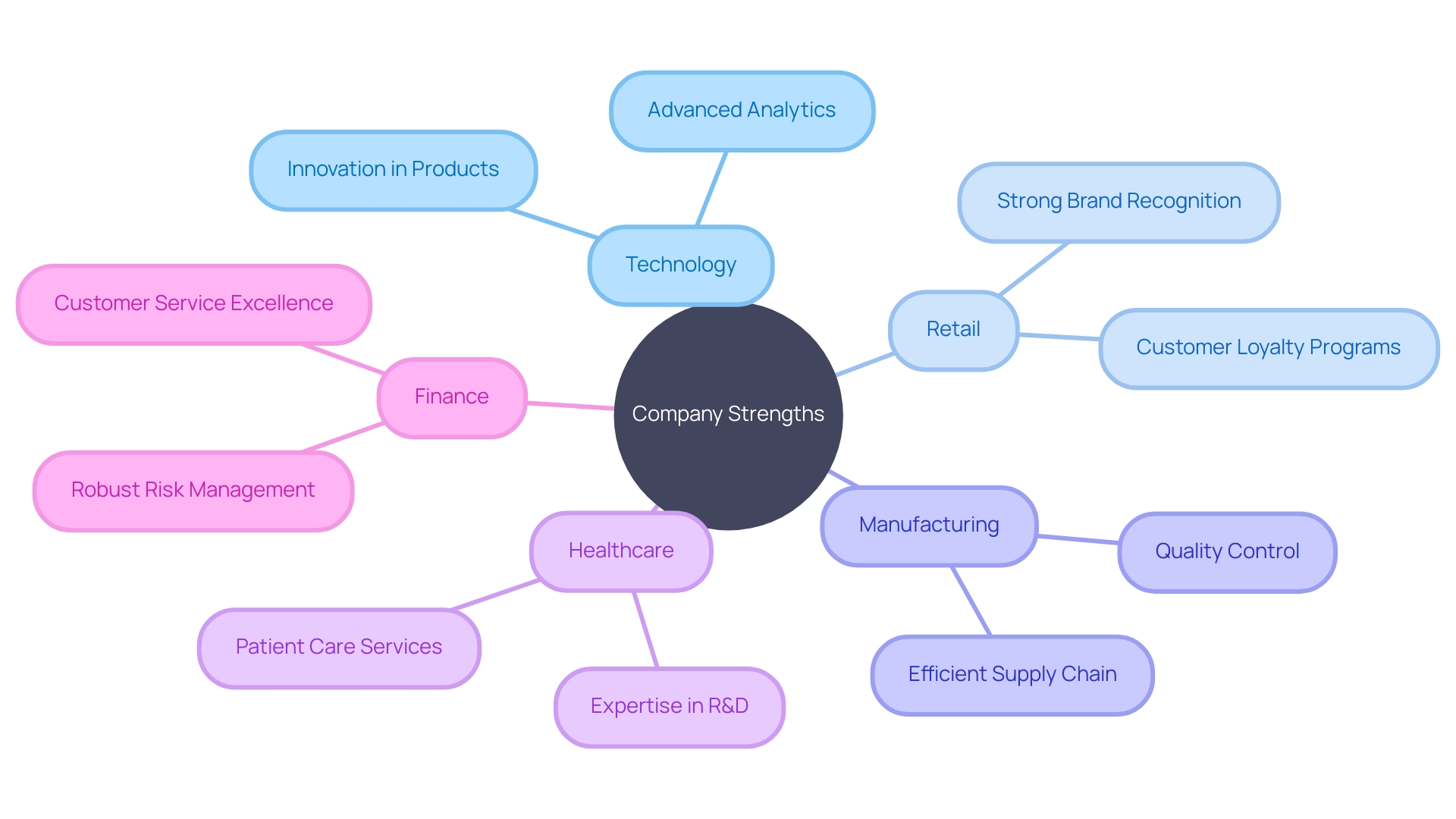
Identifying Weaknesses
Uncovering weaknesses within a company is a strategic endeavor that requires a thorough and critical examination of the existing systems and processes that are not performing up to par. This examination may reveal issues such as suboptimal operation flows, constrained resources, and areas where the organization's know-how is insufficient. These vulnerabilities, left unaddressed, can stall company growth and progress.
For instance, startups can flourish by recognizing and daring to execute ideas that incumbents hesitate to explore, seizing market opportunities that others may overlook. Established companies, on the other hand, might rigorously analyze new ventures via a detailed SWOT analysis to weigh the potential returns against the risks involved, thereby making well-informed decisions, consistent with their broader strategic objectives.
A pivotal element in identifying weaknesses is the ability to engage in an open and structured dialogue with both internal team members and customers. This enables businesses to timely detect signals suggesting the need for a directional shift, whether the change is a fundamental pivot or an adjustment in operations, as underscored by the need for meticulous planning and execution to navigate events such as mergers and acquisitions, which can often fall short of generating anticipated value without astute strategic preparation.
Such preparation is supported by findings highlighting that one in three small businesses have faced survival-threatening crises within the last five years. Remarkably, less than half of these companies sought exterior consultation or aid to brace for crisis, despite the increased volatility triggered by phenomena like Brexit, the Covid-19 pandemic, and the calls for environmentally responsible business practices.
The value of SWOT analysis is further asserted through advice from strategists, who emphasize that business strategies are hypotheses that we test against market responses. The rigorous analysis guides businesses to scrutinize the assumptions behind their strategies, ensuring they are grounded in reality and not in unfounded expectations. Analytical skills and stakeholder involvement are crucial across various stages for sustained competitiveness and effective alignment with market dynamics.
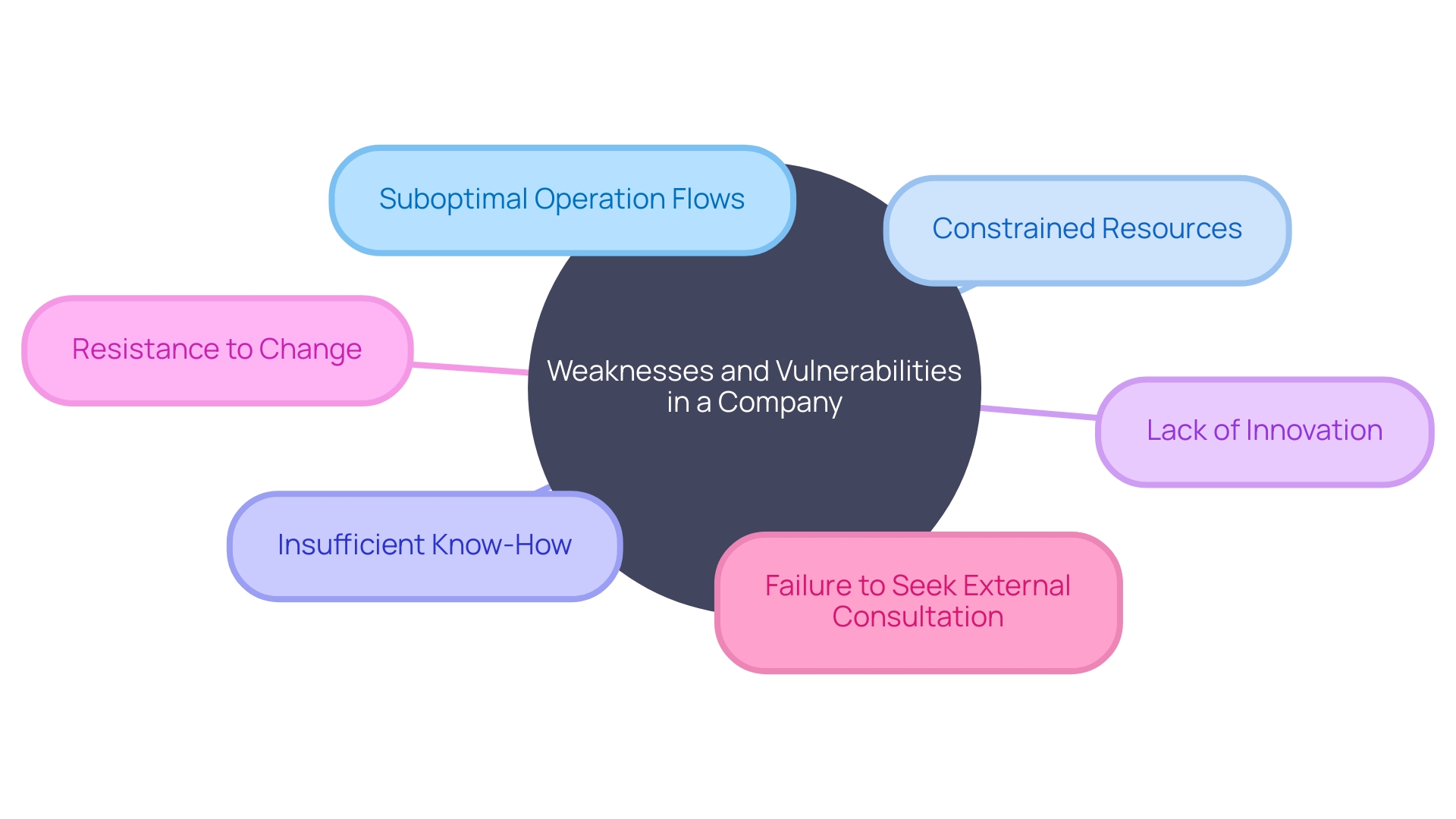
Identifying Opportunities
To harness opportunities, enterprises must meticulously examine external elements like market developments, consumer demands, competitor strategies, and technological innovations. By critically evaluating these aspects, organizations can uncover potential avenues for expansion and position themselves advantageously. Take the narrative of SellCoursesOnline, which pinpointed a prevalent challenge among entrepreneurs dealing with the technical complexities of establishing an online business presence.
Recognizing this gap, they created a centralized resource to support and equip e-learning entrepreneurs with the necessary tools and expertise, thereby capitalizing on a concrete market need.
Similarly, the founders of Custom Neon stumbled upon an untapped niche while attempting to purchase a neon sign, leading to a venture that capitalized on the unique aesthetic of LED neon signs, initially self-funded with just $250. Their strategy of starting with rentals for capital and leveraging user-generated content and word-of-mouth promotions resulted in a thriving business without initial advertising expenditures.
In a shift towards sustainable practices, H&M introduced second-hand clothing sales at their London flagship store, aligned with escalating demands for fashion industry accountability. This strategic move not only addresses consumer trends but also the industry’s pressing need to mitigate environmental impact.
Through research, collaboration with Thought Leader Groups, and observing global trends—such as the re-purposing of infrastructure to meet changing food production needs due to climate change—businesses can reconceptualize existing assets as opportunities. The consumer electronics market exemplifies this notion, with its segmentation into telephony, smart home devices, and personal computing, reflecting the industry’s adaptation to consumer needs for connectivity and entertainment, as noted in Germany's market analysis.
Capturing such opportunities necessitates a balanced judgment between the potential value and associated challenges. Categories like 'gold-mines’—those rare instances of high potential with minimal challenge—are the epitome of desirable business opportunities.
Ultimately, recognizing unmet needs and alleviating customer pain points serve as the cornerstone of innovation and competitive edge. Whether identifying inefficient processes, inadequate customer service, or privacy concerns, these unaddressed areas are ripe for the introduction of novel solutions, as evident from the expansion of smart home device demand in the U.S. market.
By methodically evaluating these factors against the changing dynamics of the competitive landscape, including post-COVID shifts and regional developments, businesses can make informed decisions on where to concentrate their efforts for optimal gains.
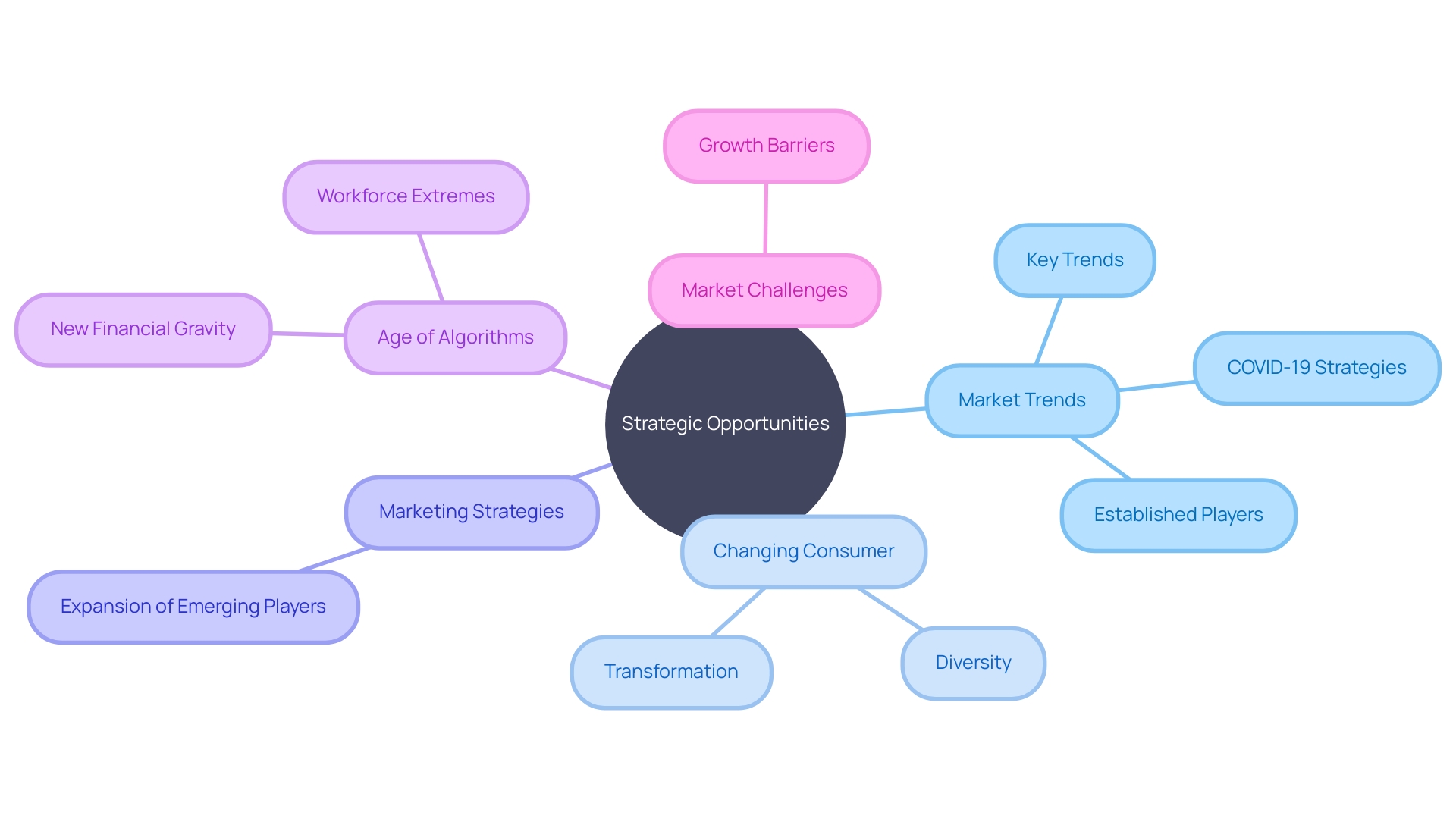
Identifying Threats
In the dynamic world of business, threats are ever-present and originate from numerous external sources. These threats, ranging from shifts in market dynamics to the surge of new rivals, are perpetual challenges that can derail a company's trajectory. Regulatory revolutions and economic shifts add another layer of complexity to the corporate landscape.
For example, a case involving an AWS client underlines the subtlety with which external parties can introduce threats. An unauthorized IAM user requested an increase in the email sending limits for a service the client wasn't using, posing a significant threat to the organization's operations. Such incidents underscore the importance of identifying and mitigating potential threats through astute contingency planning, allowing a firm to respond effectively and preserve its standing in the market.
Real-world incidents serve as a fulcrum for understanding and addressing potential vulnerabilities. The recent malicious attack on a client's AWS account unfolded over a month with various phases of activity. The precision and meticulousness of a structured approach, such as the MITER ATT&CK framework, aid in dissecting these phases, providing businesses with a pragmatic methodology for understanding threats.
This, coupled with a collective commitment to AI security and transparency, promotes a more robust response to such adversarial risks.
Navigating the corporate world's treacherous waters means being mindful of the cautions shared by business scholars: 'Your ability to perceive the likelihood and severity of an adverse event is based on past experience and previous results. 'These insights from 'The Most Important Business Book of the Year: 'How Big Things Get Done',' compel businesses to cultivate enhanced risk intelligence through constant vigilance and informed decision-making.
In tandem with internal vigilance, market trends and sentiments cannot be disregarded. Studies, such as those by the American Customer Satisfaction Index (ACSI), reveal that customer satisfaction can significantly influence stock market performance, echoing the sentiment that consumer treatment is paralleled by financial reward or punishment. Against this backdrop, continuous evaluation of external threats becomes a critical dimension of strategic planning, equipping businesses with the foresight needed to sustain growth and seize success.
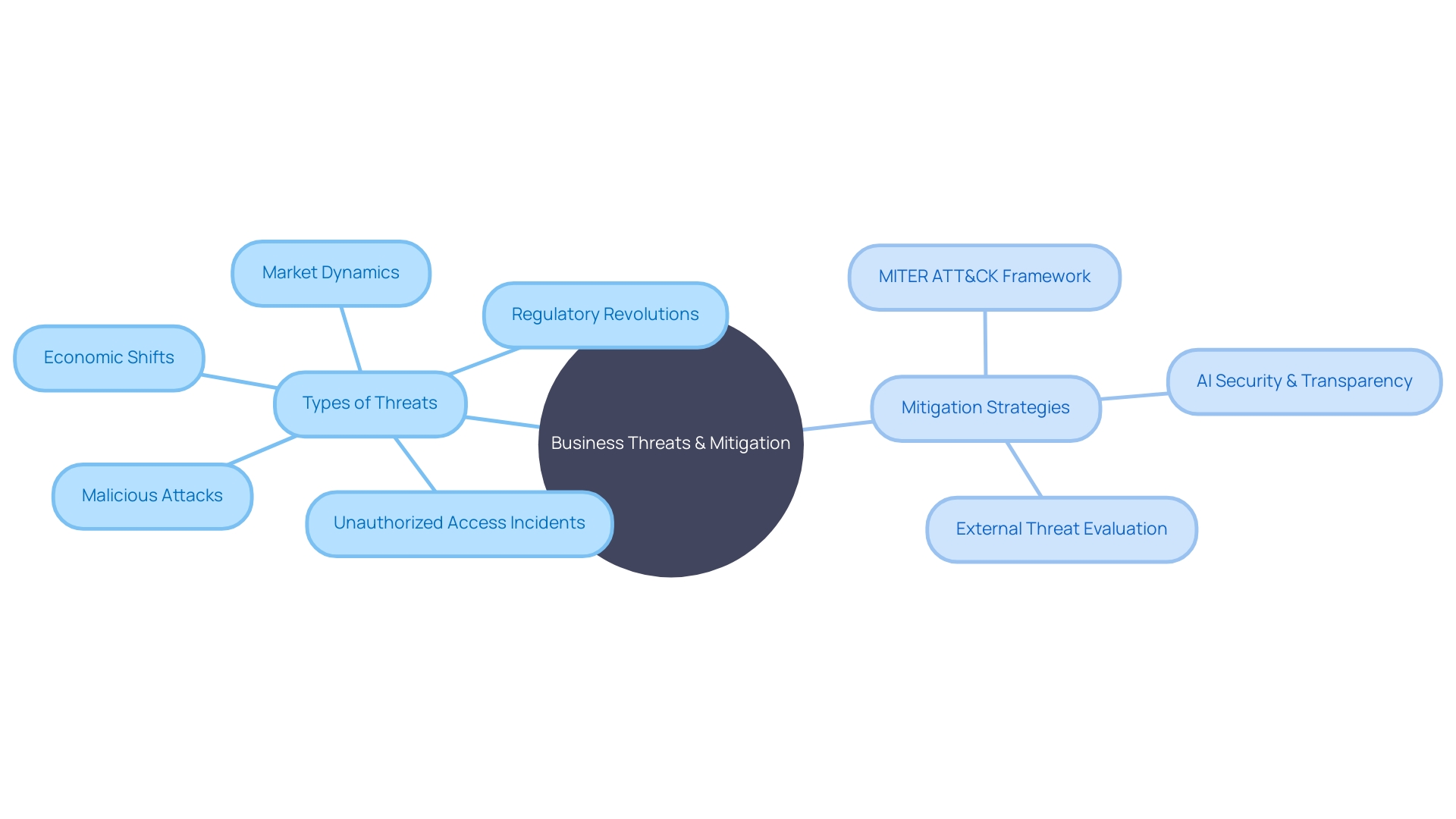
Practical SWOT Analysis Examples
Exploring real-world applications of a SWOT analysis reveals its foundational role in strategic planning. For example, Nets, a European provider of digital payment solutions, relies on SWOT to navigate industry changes and maintain relevance. A SWOT analysis enabled Nets to convert complex technical data into an accessible format, enhancing the onboarding process for new employees and setting the stage for future growth.
The value of SWOT analyses is not confined to established enterprises; it's also evident in the technology sector. Intel's recent struggles, characterized by a significant stock price drop and workforce reductions, spotlight the necessity for ongoing skills development in the face of rapidly evolving AI and automation. This is echoed by IBM's Business Value study, which predicts a substantial need for reskilling, impacting 1.4 billion employees worldwide.
SWOT's utility stretches beyond corporate strategy to encompass individual projects and decision-making processes. It offers a 360-degree perspective on a business's internal strengths and weaknesses—like workforce expertise and financial health—while assessing external opportunities and threats, some uncontrollable, such as economic shifts or competitive landscapes. These insights are pivotal for executives grappling with the challenges of repurposing assets, addressing skill shortages, and steering companies toward sustainable growth paths.
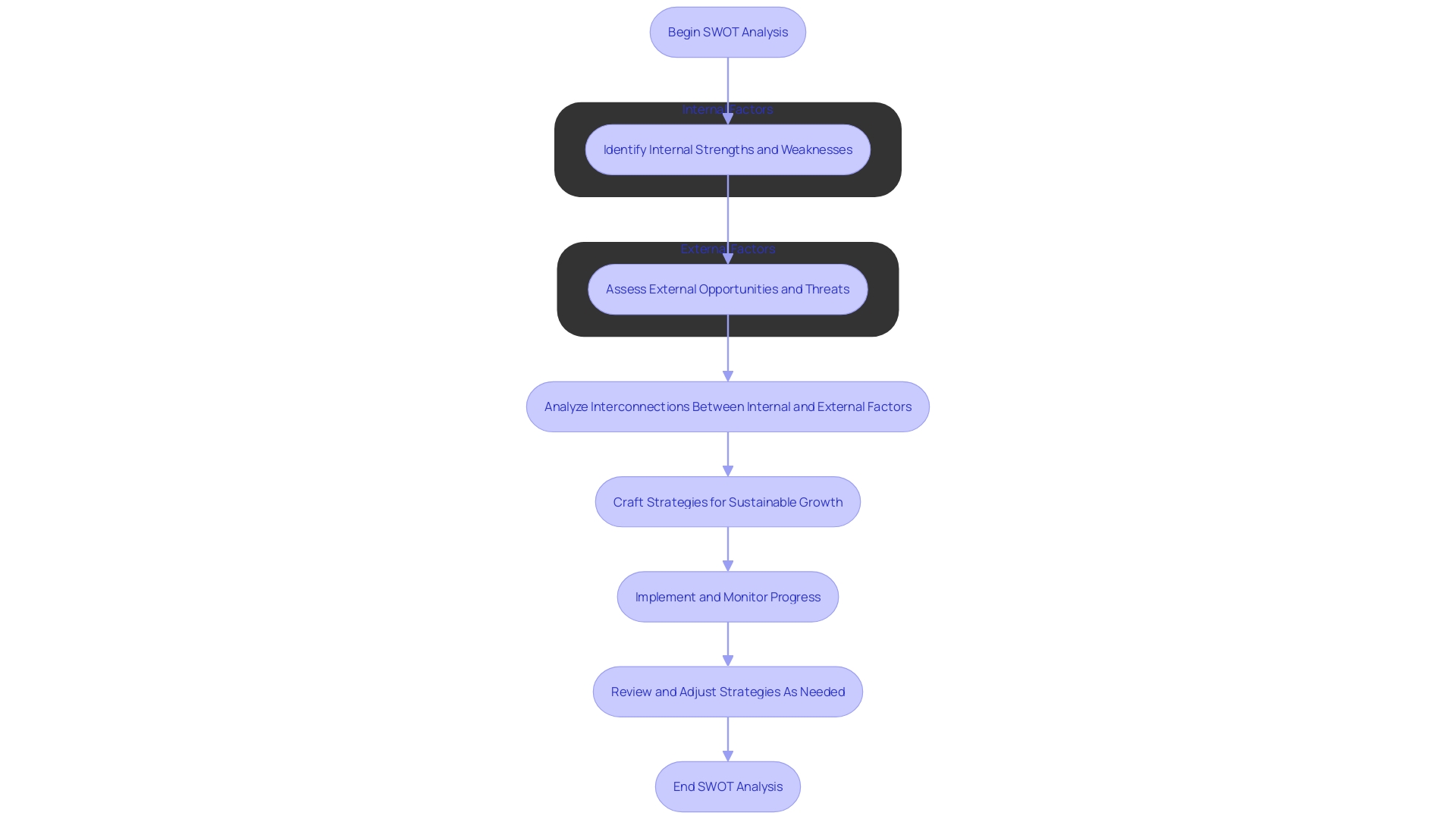
Example 1: Family-Owned Restaurant
- Strengths:
- Renowned for exceptional service and quality, as evidenced by institutions like Levi Strauss and L’Oréal, which epitomize the strength and longevity that family-owned businesses (FOBs) can achieve.
- Unique offerings, such as beloved family recipes, which can become a cornerstone of a business’s identity.
- Expert staff, which forms the backbone of a company’s success and can create an environment that amplifies the potential of the business.
- Weaknesses:
- Scarce resources for marketing initiatives, often a challenge for smaller, local businesses which may inhibit growth potential.
- An absence of a strong digital footprint which is increasingly becoming vital in the digitally oriented consumer market.
- Variability in business volume with seasons, which can lead to inconsistent revenues throughout the year.
- Opportunities:
- A growing appetite for locally-sourced ingredients creates an avenue for partnerships with local suppliers, echoing the trend of Travel Charme Hotels & Resorts in leveraging local uniqueness for success.
- Potential for synergies with local wineries and breweries, which can enhance the customer experience and diversify offerings, as understood from the wine industry's business models.
- Threats:
- Escalating food costs, which according to U.S. Department of Agriculture have risen significantly, placing additional strain on profit margins.
- Increased competition from chain restaurants, which have the scale to potentially undercut prices and offer consistent year-round services.
- Evolution in consumer tastes and expectations, which necessitates continuous innovation and adaptation to stay relevant.
Example 2: Marketing Campaign
Strengths
- Strong brand identity
- Extensive customer database
- Creative and innovative marketing team: Inspired by the Bosch Group's successful overhaul as an IoT company and the subsequent creative campaign by Jung von Matt that associated this traditional industrial powerhouse with modern IoT solutions, our team reflects a similar spirit and innovation potential.
Weaknesses
- Limited budget for advertising: This constraint can be seen in the broad context of advertising effectiveness, where budget allocations must be smartly strategized to ensure that every dollar spent contributes substantially to campaign objectives.
- Lack of market research: It mirrors broader industry trends as demonstrated in the Cannes Lions International Festival where it was highlighted that understanding brand status, competitive context, and cultural nuances across markets is critical for creating resonant campaigns.
- Inconsistent messaging: The principle of consistency in brand messaging has been reinforced by using first-party data to create highly targeted and timed offers as showcased in car dealership digital platforms.
Opportunities
- Social media advertising: With an astonishing 5.04 billion global users, social media platforms present an unrivaled opportunity for brands to reach and engage with their audience.
- Strategic partnerships with influencers: As reflected in the partnership collaborations between public facing organizations for brand awareness, utilizing influencers can leverage their reach and credibility for enhanced exposure.
Threats
- Increasing ad costs: In a climate of rising advertising costs, it is imperative to make strategic decisions like Vodafone's latest partnership with Microsoft aimed at leveraging cutting-edge technology for transformative customer experiences.
- Competitor marketing campaigns: Staying ahead requires careful monitoring of competitive strategies, calling for a deep understanding of market trends akin to Pepsi's evolving brand positioning against Coca-Cola.
- Negative customer reviews: The impact of customer sentiment remains pivotal, with proactive engagement strategies being necessary to maintain a positive brand image.
Example 3: Content Marketing Strategy
The strengths of the well-established blog, notably its high traffic and active social media engagement, provide a potent platform for influencing its audience. The expertise of its content creators is a critical asset in crafting compelling narratives that resonate with readers. However, an irregular content publishing schedule poses a significant challenge to maintaining audience interest and loyalty.
Limited promotional resources further constrain the potency of the blog's outreach and influence. Moreover, a deficiency in SEO optimization can stifle visibility, hindering potential growth.
In terms of opportunities, forging partnerships through guest blogging on industry-leading websites and collaborating with influencers broadens the horizon for the blog's content distribution and authority. Such strategic alliances can also amplify its voice in an increasingly crowded digital space. Nevertheless, threats like ever-evolving search engine algorithms can disrupt traffic flow and content visibility.
Furthermore, the blog faces intensified competition from a surge of content creators and a shift in social media algorithms that could potentially reduce its reach.
Insights reflect that content remains paramount, contributing up to 30% of web traffic. A well-rounded content strategy transcends mere blogging to encompass multiple formats and touches across the customer lifecycle, from acquisition to referrals. For instance, sophisticated keyword research, not just a rudimentary practice, becomes essential enabling content to target precisely what audiences seek.
Its high priority and low effort can yield rich dividends in terms of traffic and engagement. An actionable roadmap begins with thoroughly understanding the unique DNA of the business, identifying the target audience, and customizing the content to address their needs, utilizing market research to strategically place content where potential customers are most active.
As per the latest trends, the efficacy of content marketing is underscored by the fact that nearly half of the companies can't gauge its impact, despite increased content production and investment. The demand for a strategic pivot is clear—no longer can entities afford to operate without comprehensibly understanding how their content drives their business. With content's undisputed sovereignty in the digital realm, developing an informed, versatile content strategy becomes indispensable for staying competitive and achieving desired outcomes.
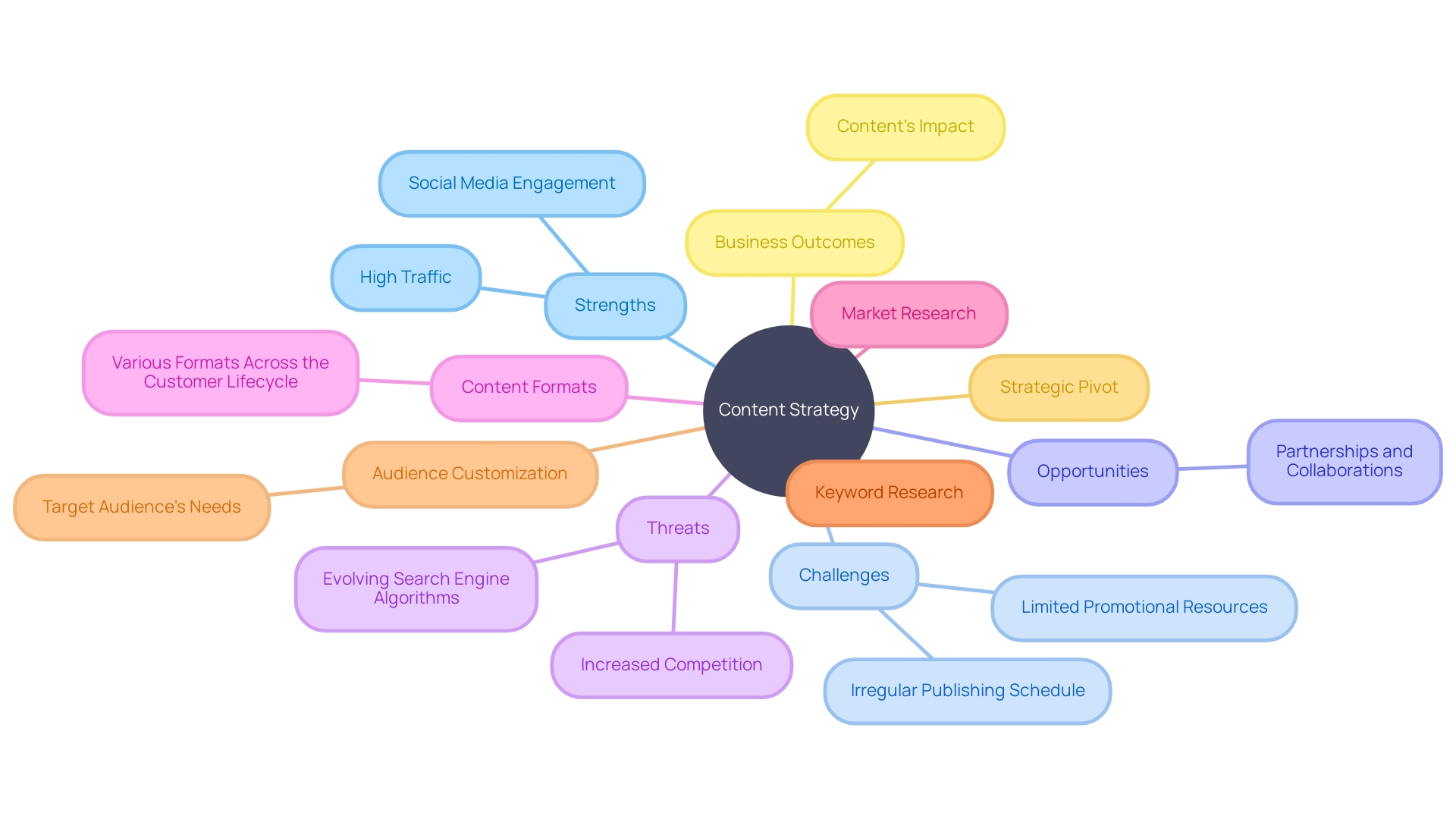
Actionable Strategies from SWOT Analysis
Drawing on a SWOT analysis allows businesses to establish strategic initiatives that bolster success. In analyzing a case like Spotify, which transformed the audio streaming industry, we see the power of aligning a company's strengths—such as a vast music library and innovative features—with market opportunities. By also recognizing weaknesses and potential threats, like competitive pressures and regulatory changes, Spotify could pivot and adapt effectively, contributing to its massive expansion to over 170 countries and reaching over 500 million active users.
Furthermore, leveraging the big picture provided by a SWOT analysis can better inform long-term decisions beyond immediate consequences. Such an approach enhances communication and collaboration across different business segments, fostering a unified vision for success. For startups particularly, a SWOT analysis is indispensable.
Employing it not only ensures a smoothed-out launch but also equips companies to confront the complexities of the marketplace with a defined direction and robust foundation.
To extract actionable strategies from SWOT findings involves several critical steps. Initially, identifying the company's inherent strengths and weaknesses paves the way for determining how resources should be allocated. Then, by evaluating external opportunities and threats, organizations can hone in on strategic priorities that drive growth and mitigate risks.
This heightened insight leads to smarter decision-making and aids businesses in crafting a future-proof strategy. Crucially, a SWOT matrix is designed to be quickly digestible, allowing key players to grasp essential internal and external factors rapidly. This clarity ensures that opportunities for enhancing strengths and addressing weaknesses are not overlooked and that companies can navigate their industries with agility and informed clarity.

Matching Strengths with Opportunities
By scrutinizing both their core competencies and windows of possibility, companies can craft strategies that augment their position in the market. As an illustration, consider a family-operated eatery that boasts a distinctive recipe passed down over generations. This establishment can ride the wave of a growing consumer appetite for locally sourced produce by emphasizing their commitment to local ingredients within their promotional activities.
Strengthening the connection between strategy and innovation is crucial, as it powers bottom-line growth through leveraging unique advantages aligned with strategic objectives, a concept underscored by twenty years of digital strategy research with Fortune 500 firms. Walmart, through problems and opportunities lenses, has effectively taken strides in linking strategic foresight with innovation, enhancing their ordering processes, and tackling customer attrition.
Successful business transformation often begins with a mindset shift towards tackling problems first, then exploring strategic levers like SWOT analyses and fiscal agility through careful cost management and funding options. Visionaries in the industry are transforming themselves into change agents, challenging conventions, and adopting 'Ruthlessly Constructive' approaches to ensure future success by facing hard realities with positivity.
Trends in the food and beverage sector show this strategy in motion, led by technological advancements such as AI and evolving consumer demands. The backing of green technologies and community engagement, similar to Mucci Farms' lit culture grow light program, conveys the promise and potential of integrating corporate strategy with innovative, consumer-focused practices.
Converting Weaknesses into Strengths
Utilizing SWOT analysis, companies assess their strategic positioning and develop actionable plans by leveraging their strengths and addressing their weaknesses. For example, a firm with a modest marketing budget, which could be construed as a weakness, might repurpose this limitation as a fortification by optimizing lower-cost channels. Social media outreach and forming alliances with influencers are cost-effective tactics for expanding market reach without substantial expenditure.
Focusing on such innovative approaches aligns with the insights extracted from SWOT analyses, which underscore the importance of internal resources like financial well-being and technological advantages.
Case studies from various industries reveal how allocating resources effectively—like using AI for analytical insights or employing big data to craft targeted marketing strategies—can transform weaknesses into competitive strengths. Moreover, the ever-growing utilization of social media, as evidenced by the 5.04 billion global users, illustrates the significant opportunity for organizations to pivot towards these dynamic platforms. This transition not only facilitates access to a broader audience but also complements a company's capability to adapt to market changes and manage potential vulnerabilities.
In light of these considerations, businesses are encouraged to adopt a holistic approach, aligning their strategic objectives with the real-time data and insights that a robust SWOT analysis affords. Such strategic planning is not only crucial for understanding both the internal and external factors affecting success but also for thriving in a competitive business environment.
Overcoming Threats with Opportunities
When faced with increasing advertising costs, businesses have an opportunity to explore and pivot towards alternative marketing channels. A successful approach could involve content marketing or leveraging influencer partnerships, strategies that can offer a more cost-effective means of engagement and can potentially yield a significant increase in brand visibility and sales. Taking a cue from a major hotel brand, despite an advantageous location in the city center, its restaurant struggled to grow its food and beverage sales.
The solution? A strategic pivot aimed at leveraging its prime location to attract more diners, resulting in impressive reviews and sales uplift within the first week.
Moreover, the importance of having a nuanced digital strategy cannot be overlooked. Research suggests an alarming statistic that nearly half of U.S. small businesses lack a website. In today's digital economy, a strong online presence, reinforced by effective search engine optimization (SEO), is crucial for outmaneuvering competitors.
This holds especially true if the competition has yet to establish a significant online footprint. In such cases, being the sole digital player could be an ample advantage.
Adopting a digital-first approach also corresponds with the renewed vigor observed in the digital advertising space. With major companies experiencing substantial growth in their ad segments, it's clear that a strategic focus on digital platforms, whether through social media like Facebook and Instagram or through implementing SEO strategies, is essential.
Finally, 'How Big Things Get Done' underscores the necessity for businesses to sharpen their risk intelligence and prioritize opportunities that present a high potential with manageable challenges. Staying focused and aiming at 'gold-mine' opportunities — those with the highest potential for value creation and the least barriers to success — can guide businesses in their strategic decisions. In essence, the power of SWOT analysis lies in its ability to transform insights into actionable strategies that properly align with market trends and consumer demands, ultimately steering businesses to thrive amidst changing economic landscapes.
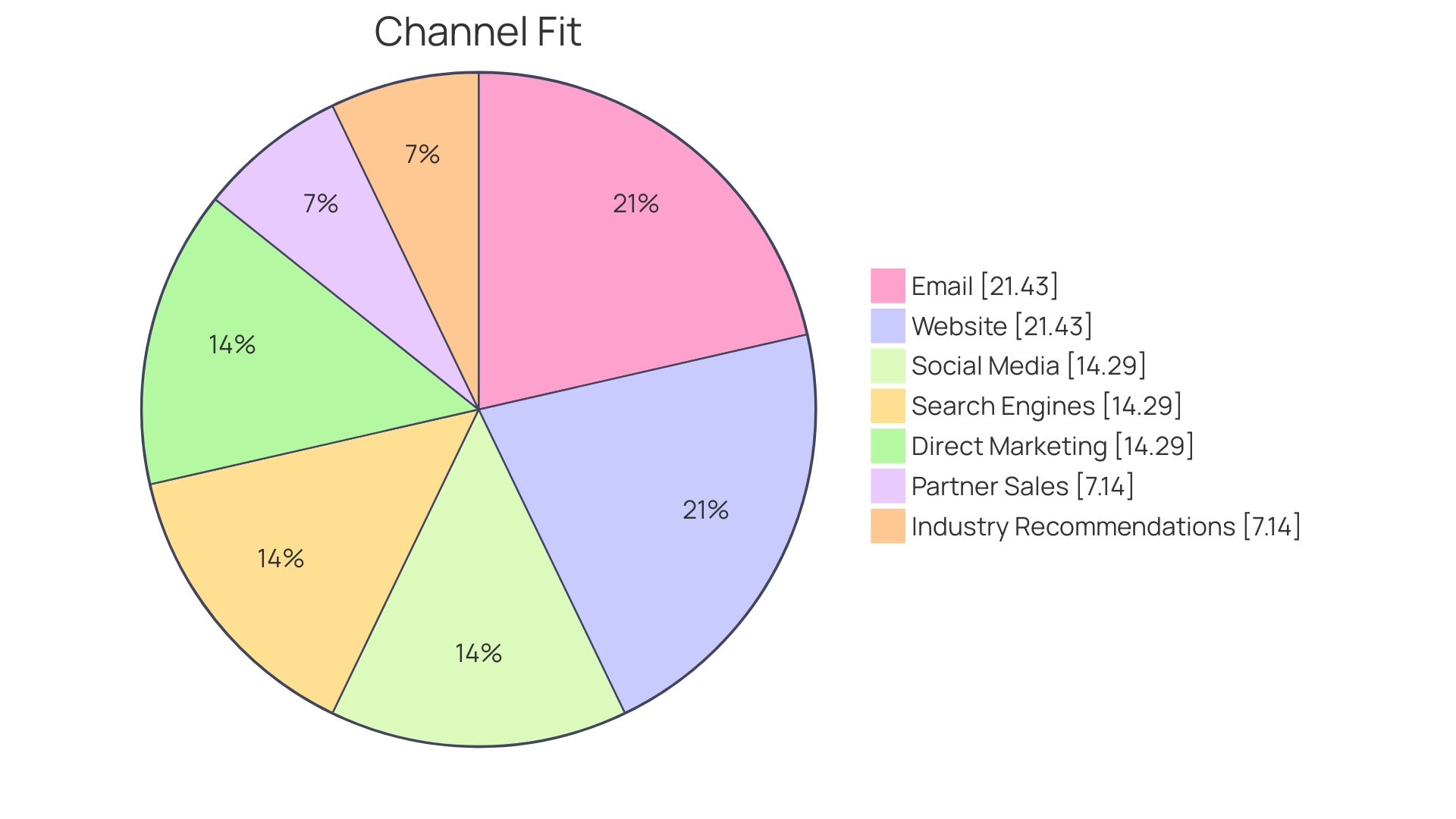
Implementing SWOT Analysis Results
For businesses to derive actionable strategies from a SWOT analysis, it is essential to develop a detailed action plan, which articulates specific objectives, delineates clear timelines, and designates accountable individuals. Take for example Nets, a digital payment solutions provider with over half a century of expertise. They faced the challenge of presenting complex technical data in user-friendly formats.
Their innovative approach was not only to deliver the content but also to engage users in exploring it autonomously. Similarly, employing such dynamic methods post-SWOT can catalyze the understanding and engagement of your team, ensuring your business stays nimble in a fluid market.
While strengths enable businesses to leverage their unique capabilities, continually navigating through challenges like regulatory alterations, even threats as subtle as changing customer expectations, demands vigilant reassessment of your SWOT analysis. For instance, financial sector businesses often require staff training to keep abreast with compliance standards. A living, breathing SWOT analysis empowers these firms to adjust their strategies effectively amidst the stringent industry requirements.
It's not merely about identifying what a business does well, as much as it is about understanding the context it operates within and being prepared to adapt growth paths like customer experience. A thoughtfully executed SWOT analysis is a comprehensive view of the organization's landscape - pinpointing strengths like financial wellness and technological prowess, identifying any potential weaknesses, and aligning goals with market realities for strategic decision-making.
Conclusion
In conclusion, a SWOT analysis is a powerful tool for businesses to assess their strengths, weaknesses, opportunities, and threats. It provides a comprehensive view of the business landscape and informs strategic decision-making. By leveraging strengths, addressing weaknesses, capitalizing on opportunities, and mitigating threats, organizations can develop actionable plans for long-term success.
The importance of conducting a SWOT analysis lies in its ability to provide a balanced overview of the competitive landscape. It enables businesses to understand their position and potential in the market. By identifying internal strengths and weaknesses, companies can leverage their advantages and address areas for improvement.
Additionally, evaluating external opportunities and threats allows organizations to capitalize on market trends and mitigate potential risks.
Implementing the findings of a SWOT analysis requires developing a detailed action plan with specific objectives, timelines, and assigned responsibilities. By continuously reassessing the analysis, businesses can adapt to changing market dynamics and emerging threats, ensuring long-term success.
Practical examples demonstrate the versatility of SWOT analysis across various industries. From family-owned restaurants to marketing campaigns and content marketing strategies, businesses can align their strengths with opportunities, convert weaknesses into strengths, and overcome threats through innovative solutions. This strategic approach helps businesses thrive in today's competitive business environment.
In summary, SWOT analysis provides businesses with insights that help them navigate the complexities of the marketplace. By leveraging strengths, addressing weaknesses, capitalizing on opportunities, and mitigating threats, organizations can develop actionable plans for long-term success. It is a valuable tool for strategic planning and decision-making, allowing businesses to stay competitive and achieve their goals.




